|
LONG SERVICE & GOOD CONDUCT MEDAL
for the
All research and images on the LS&GC medal courtesy of Ed Paquette
The Royal Canadian Navy was established in 1910 and modeled largely on the customs and traditions of the Royal Navy. Accordingly, on the 19th of June 1925 the tradition of recognition of 15 years of service, with a corresponding record of good conduct, by Petty Officers and men was instituted in the RCN. Recognition took the form of a medal of silver, which hangs from a straight clasp and bears on its obverse the effigy of the reigning Sovereign with the appropriate legend. The reverse depicts a ship of the line under sail encircled by a rope tied off at the bottom by a reef knot, around the outside of which is the inscription "FOR LONG SERVICE AND GOOD CONDUCT". Recipients who complete an additional fifteen years service under the same conditions as the original award are entitled to a clasp. Possessors of the clasp wear a rosette on the ribbon when it is worn alone.
In 1927 the first medals bearing the effigy of King George V in an admiral's uniform were issued to entitled men of the R.C.N. The medal continued to be issued to those eligible until it was superceded by the Canadian Forces Decoration (CD) which was introduced in 1950. Those who had service in the Naval Forces of Canada prior to the 10th of September,1939 were allowed to choose either the R.C.N. LS & GC or the CD. Those who were enrolled after the 10th of September 1939 were automatically awarded the CD at the appropriate time. However, the final issue of the Naval LS& GC did not occur until 1966. This was likely due to the recipient having enlisted prior to the cut-off date but having broken service.
A total of 864 medals were issued to the Royal Canadian Navy with three second award clasps. The medals were issued with seven different obverses as follows:
Up to 1966 a total of eight medals had been replaced due to loss or other causes and are not included in the totals given here.
Naming on the medals issued to Canadians was different from those issued to the Royal Navy. Medals of the R. N. carry the individuals number, rank, name, and ship. While those of the Royal Canadian Navy carry the man's rank, name and number, followed by the letters R.C.N. For some obscure reason the names of ships were not inscribed on Canadian medals.
The following are examples of medals with their exact naming as it appears on the medals.
Note: Naming on George VI medals has been found in the following formats: (a) Rank, name, RCN, and number (b) Rank, name, number, and RCN (c) Name, rank, number, and RCN
Clasp for the RCN LS&GC medal
At about the same time as the volunteer reserve (R.C.N.V.R.) was authorized, a seaman's reserve was also authorized. It was to comprise of men who had followed a seafaring career in foreign-going, coasting, fishing or other vessels. Thus the R.C.N.R. came into being.
The R.C.N.R. was originally organized in nine port divisions, which were soon afterwards reduced in number to five. They were headquartered in the following homeports: Charlottetown, Halifax, Quebec, Montreal, and Vancouver. Entrants were required to engage for one or more periods of 5 years. For enlisted personnel official numbers were prefaced by an alpha character, which designated the period of engagement. For example D-48 Leading Seaman W. S. Woods indicates that Woods was in his forth period of engagement. He would have started his first enrollment as A-48.
In 1937 another type of reserve came into being with the establishment of the Fishermen's Reserve a branch of the RCNR. As the name implies this reserve was largely made up of fishermen. The Firshermen's Reserve had its own numbering system and they were prefixed by the letters "FR". In the late 30s rewards for long service by officers and men of the R.C.N.R. were authorized. While the medals and decorations were identical to those of the R.C.N.V.R., ribbons were distinctive to the R.C.N.R.
Medal
The R.C.N.R. medal for long service and good conduct was given after a rating had completed 15 years of qualifying service and had completed the prescribed drills and training. War service time was reckoned to count as double toward the 15-year requirement. Completion of a second period of qualifying service was marked with the award of a bar to the medal. It bears on the obverse the bust of the reigning sovereign; on the reverse a broadside view of the battleship H.M.S. Dreadnought beneath which is the motto Diuturne Fidelas (For long and faithful service). The silver medal hangs from it ribbon, 1 1/4 inches wide, from a straight suspender. The ribbon originally was solid green in colour but this was changed in 1941 to green with white edges and a central white stripe. Naming of the medals is around the edge with number, rank, name and the letters R.C.N.R. Medals were awarded with only one obverse, that of George VI with the pre 1948 legend. This medal was superceded in 1946, with the amalgamation of the R.C.N.V.R. and the R.C.N.R. into the R.C.N.(R), by the long service and good conduct medal of the R.C.N.(R). There were 54 R.C.N.R. long service medals awarded with one second award bar.
Decoration
The R.C.N.R. decoration was conferred upon officers who had complete 15 years of service. The decoration is inscribed on the plain reverse with the officer's rank spelt out in full on the first line, name on the second line and on a third line the letters R.C.N.R. Like the medal for long service the decoration also hung from a solid green ribbon but 1-˝ inches wide. It also was changed in 1941 to green with white edges. Officers who had earned the R.C.N.R. decoration had the letters R.D. annotated after their name in the navy list. There were 37 R.C.N.R. decorations awarded. There is no provision in the original warrant for a bar to this award.
The decoration is in the form of an oval medallion in silver and gilt. In the centre is the GRI cypher (in gilt) surrounded by a loop of cable (in silver) tied off at the bottom with a reef knot and at the top a King's crown (also in gilt).
Note (1): Woods was awarded the medal in 1938 with the solid green ribbon, while Clark's was awarded in 1951 with the green and white ribbon. Note the difference in naming.
Note (2) : For the RCNR Decoration a small strip of the post 1941 ribbon has been superimposed on the ribbon to show the differences between the two
Clasp for the RCNR LS&GC medal
ROYAL CANADIAN NAVAL VOLUNTEER RESERVE
While Canada had struggled for many years to come to grips with the requirement for a distinctly Canadian naval presence on the world scene nothing much happened before the establishment of the Naval Act of 1910. The Act made provision for Naval Reserves however no official action was taken until the outbreak of the First World War. At this time a naval reserve named the Royal Naval Canadian Volunteer Reserve (R.N.C.V.R.) was formed and many of its members were to see service in home waters and abroad in Royal Navy ships. At the end of the war this service was disbanded.
On January 31st 1923 a truly Canadian naval volunteer reserve came into being by Order In Council #139. The use of the "Royal" prefix was granted that same year and the R.C.N.V.R. was born with an authorized compliment of 70 officers and 930 men. Later that same year the first of a cross-country net work of reservists units was formed in Montreal with the commissioning of H.M.C.S. Donaconna.
The RCNVR was originally organized into 14 companies or half-companies in each of the following cities: Vancouver, Calgary, Edmonton, Regina, Saskatoon, Winnipeg, Hamilton, Toronto, Ottawa, Montreal, Quebec, Saint John, Charlottetown, and Halifax. Montreal actually had two companies one French speaking (Cartier) and the other English (Donaconna).
In 1937 another type of reserve came into being with the establishment of the Supplementary Reserve a branch of the RCNVR. This reserve was largely made up of yachtsmen.
Additional naval divisions were established in Kingston, London, Port Arthur and Prince Rupert bringing the total to 18 by the start of the Second World War in September 1939. During the war two more, one in Victoria and the other in Windsor, were also added. With Newfoundland's entry to the Confederation a reserve division at St. John's was established in 1949.
On November 1st 1941 the Reserve Divisions were commissioned as ships.
Medal
In 1938 it was determined that recognition of long service in the R.C.N.V.R. was required. Consequently a medal was authorized for awarded to Petty Officers and men of the volunteer reserve who had completed 12 years of service with accompanying good conduct. A further 12 years of service with accompanying good conduct would be recognized with the award of a bar to the medal. When the ribbon alone is worn, the possession of a bar is denoted by the addition of a silver rosette to the ribbon.
The silver medal hangs from its ribbon, 1 1/4 inches wide, from a straight suspender. It bears on the obverse the bust of the reigning sovereign; on the reverse a broadside view of the battleship H.M.S. Dreadnought beneath which is the motto Diuturne Fidelas (For long and faithful service).
Medals are found with only one obverse that of George VI with the pre-1948 legend. Naming of the medals is found around the edge and includes the rank, name, number and R.C.N.V.R. The order in which this information appears on the medal is dependant upon the date at which the medal was awarded (see examples).
Decoration
Unlike the Royal Canadian Navy, officers of the R.C.N.V.R. were awarded recognition for their long service. This was in the form of the Royal Canadian Navy Volunteer Reserve Decoration (V.D.). To earn this award officers had to complete 20 years of service. An officer awarded this honour could use the letters V.D. after his name.
The decoration is in the form of an oval medallion in silver and gilt. In the centre is the GRI cypher (in gilt) surrounded by a loop of cable (in silver) tied off at the bottom with a reef knot and at the top a King's crown (also in gilt). There is no provision in the original warrant for a clasp to this award.
Decorations are found with the GRI cypher only. Naming is engraved on the reverse and contains the officer's rank spelt out in full on the first line, name on the second line and the letters R.C.N.V.R. on the last line.
With the amalgamation of the R.C.N.V.R. and the R.C.N.R. in 1946 into the R.C.N.(R), both the RCNVR Decoration and Medal were superceded by the RCN(R) Decoration and Medal for long service and good conduct.
A total of 36 Decorations were issued; and a total of 582 Medals were awarded, to which 19 second award bars were issued. The bars would have been earned as members of the R.C.N.(R.)
The following are examples of medals with their exact naming as it appears on the medals. The naming is around the edge and in a single line.
Note (1): PO Cordy was issued his medal in 1943, while A/L/S Land was issued his in 1963 note the difference in the naming. As well even though LS Land received his medal in 1963 it bears the George VI obverse.
Note (2): A medal named "V 9346 L/S J.W.SMITH RCNVR" is known to exist and is believed to be a replacement. L/S Smith was originally issued his medal in 1943 and should be named in the same format as PO Cordy's.
Clasp for the RCNVR LS&GC medal
At the onset of World War 2 Canada’s naval capabilities were not able to meet the demands that this conflict would require. A tremendous expansion was undertaken and the ‘Navy’ grew a hundred fold. This growth was largely in the area of reserves and most notably the Wavy Navy or R.C.N.V.R. Consequently the Navy numbered some 100,000 at the end of the War.
As the War came to a close authorities had to determine the form of the new peacetime Canadian Navy. For the R.C.N.V.R. and R.C.N.R. it was determined that a new single reserve force was the best to meet any future requirement to augment the permanent force. Plans were announced in November of 1945 for a post-war reserve to be known as the Royal Canadian Naval (Reserve). Authorized complement of the RCN(R) was pegged at 18,000 all ranks. It was expected that the new reserve would be organized in 23 Divisions, 19 of which were already in existence.
In 1946 the R.C.N.(R.) came into being and the R.C.N.V.R. and the R.C.N.R. were now a part of the history of Canada’s naval history. With the creation of the new force, a new system of honours for long service would be required. The decision to continue with the award of a medal for petty officers and men, as well as a decoration for officers was made. The design and ribbon were to be the same as those used by the former R.C.N.V.R. with the new names, Royal Canadian Naval (Reserve) Medal and Royal Canadian Naval (Reserve) Decoration.
These awards were in effect until they were superceded by the introduction of the Canadian Decoration in 1950. From 1946 until the final issues a total of 19 medals and 16 decorations were awarded. To the best of my knowledge these were all of the George VI type, with the medal bearing the pre-1948 legend. Naming format of these awards was much the same as that of the honours they replaced with the inclusion of the letters R.C.N.(R.).
Clasp for the RCN(R) LS&GC medal
Although a bar to the medal was authorized no examples are known to exist. Bars were awarded to members of the RCN(R) but they were for medals earned in the R.C.N.V.R. and R.C.N.R.
|

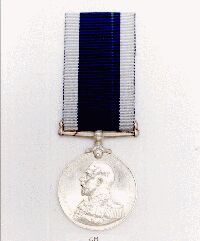
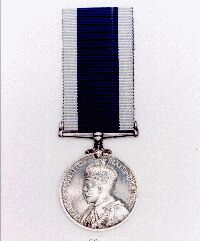
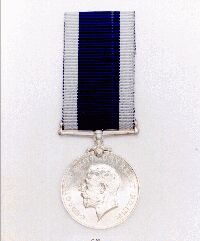
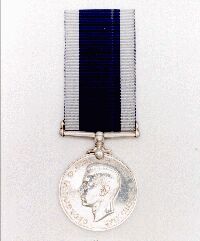
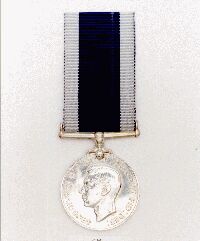
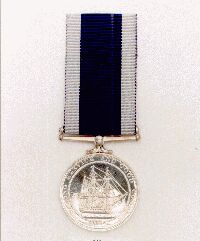
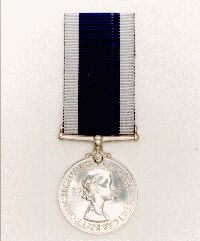


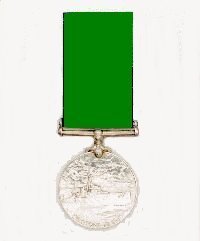
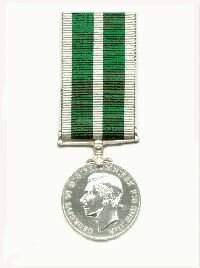
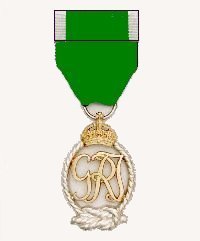

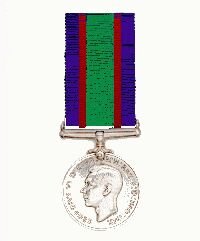
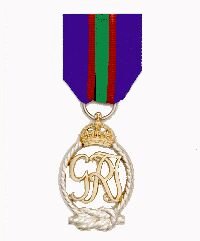
%20LS/RCNVRrev.jpg)
%20LS/RCNVRobv.jpg)
%20LS/RCNVRdec.jpg)